After days of high winds and nonstop rain, the sun eventually came out, allowing for a spontaneous trip on a glorious winters day. As the aeroplane made its gradual descent in Wellington, the striking mountains, lush green landscape and the immense waves of the ocean came into view.
[rpi]
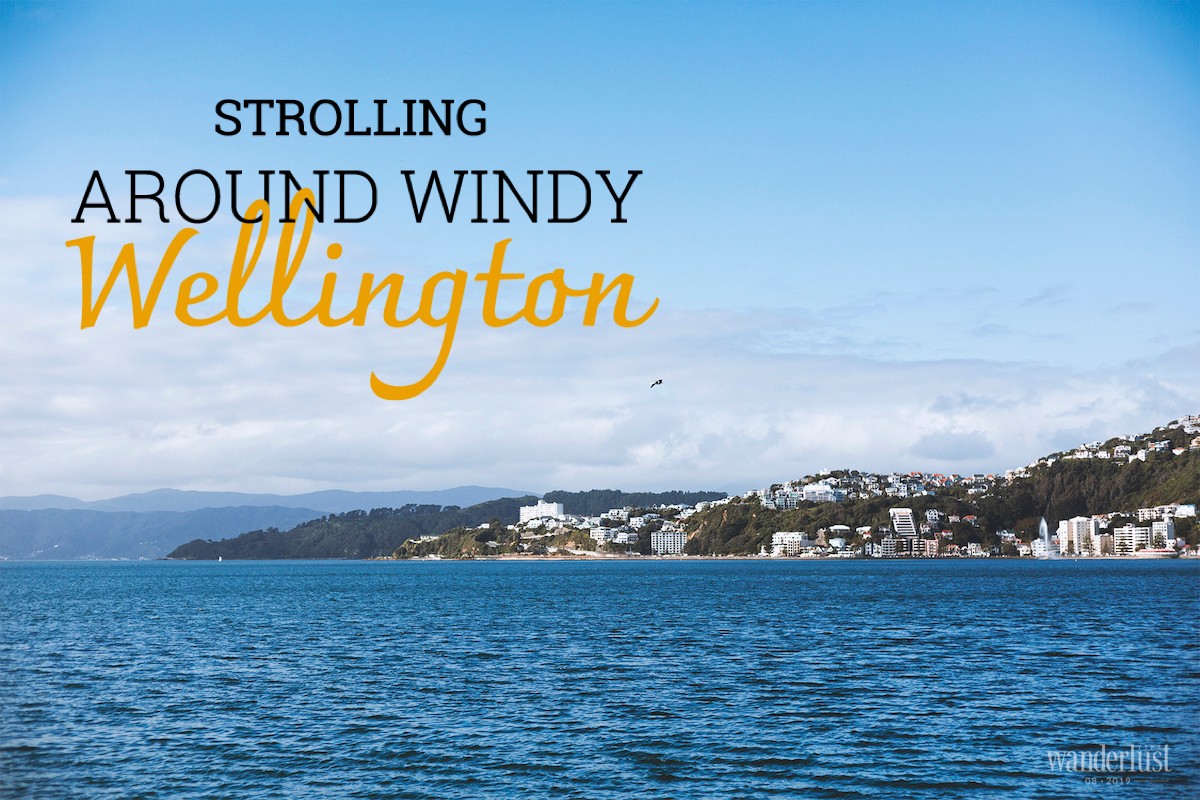
Nestled amongst all of that, you will find wellington, a city which connects the past, present and future stories of Aotearoa in New Zealand.
With a population of nearly 450,000 which is considerably less than that of Auckland’s 2.5 million, Wellington – although the small capital of New Zealand is really rather prosperous. In addition to the financial centre along Queen Street, Auckland boasts the beautiful Westgate in the west, East Tamaki a land imbued with the imprints of Māori people, and Manukau in the south surrounded by vast farms and a thriving economy in the developing north. Wellington is also divided into smaller areas including Wellington City – the central district, Upper Hutt, Lower Hutt and Porirua. Nevertheless, most residents opt to work in the central district, where they get to see the sparkling blue Wellington Harbour every day, stroll along the serene waterfront and around the park which surrounds the infamous “beehive” Parliament House – the working office of prime minister Jacinda Ardern.
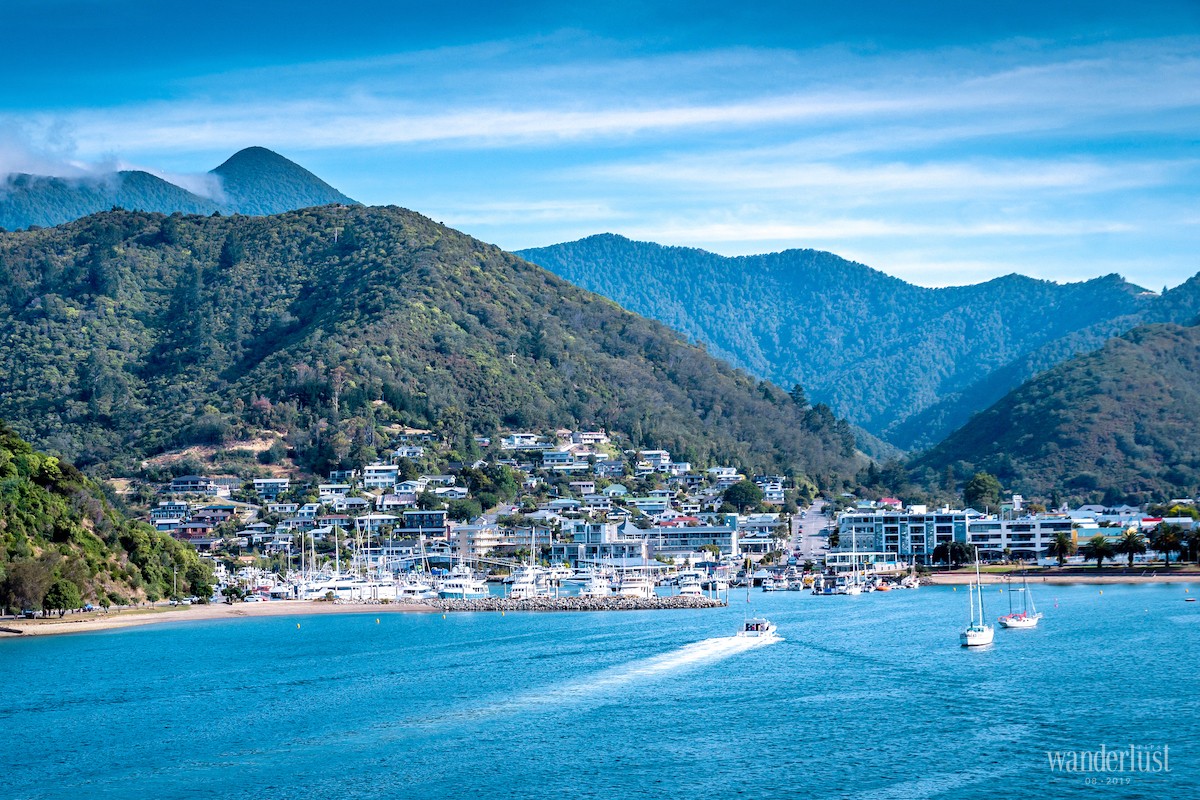
The small city also goes by a unique nickname, “Windy Welly”. Located amid layer upon layer of spectacular mountains, Wellington Harbour and Fitzroy Bay, the city gets the brunt of the strongest winds. As soon as I left the airport, I had to hold on to my jacket and scarf for fear of losing them, it was indeed a first-hand experience of “Windy Welly”. The taxi took us to the hotel via the road running through the bay. The white seagulls were beating their wings in the air. The crystal-clear water ripples like a velvet veil caught in the chilly sea breeze. The scene could very much be mistaken for the middle of summer until the door swung open and the icy winds whistled through the cabin to remind us that July was in actual fact the coldest month of the year and winter was nowhere near over.
GET LOST IN “FAIRYLAND” MOORE WILSON’S
Our trip was not meticulously planned. Everyone followed a separate schedule with only two nights in Wellington, so we parted after having a quick lunch and a cup of aromatic coffee together at The Hangar – a famous Welly cafe. What a pity it was Sunday! Wellington night market would not be open until next Friday, so I insisted on visiting Moore Wilson’s or the “Ikea of kitchenware” as I like to call it, my professor recommended it to me as the must-see place for those who are passionate about cooking.
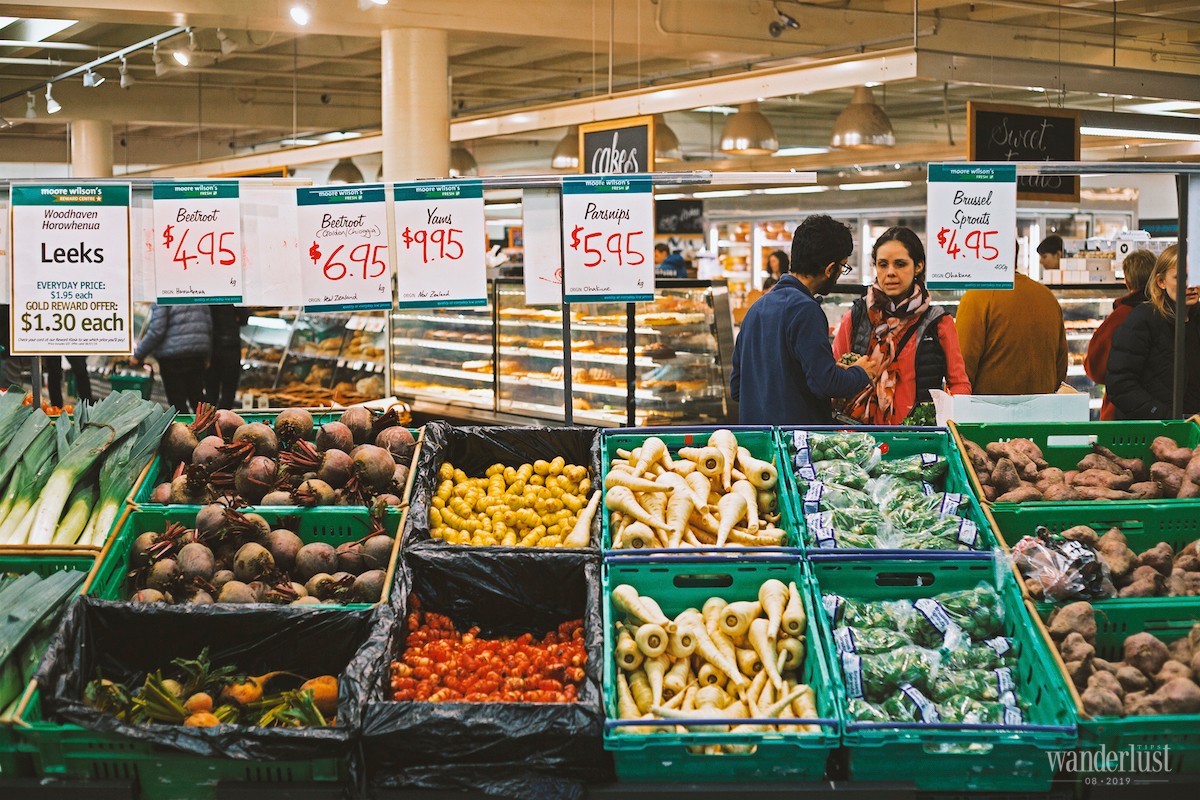
At first, I planned to buy bus tickets in the city but I appreciated that Wellington centre is small and I could walk from the northern end to the southeast end in nearly an hour. For residents here, Sunday is both a day for family and recuperation. The city also becomes more serene, the bustling streets make way for gloomy winter nights when the last of the sun’s rays disappear.
Moore Wilson’s is located a stone’s throw from the end of the southeast end of the city. Behind the corroded iron wall is a “supermarket” boasting all the fresh and dry ingredients that you can dream of. The vast amount of winter fruits and vegetables was simply overwhelming. National markets do not exist in New Zealand culture like that in other countries. Mostly, you will see small markets on weekends, supermarkets, or Asian stores like Taiping, Fresh and Save, or Lim Choi. Despite being a supermarket, Moore Wilson’s probably bears a resemblance to the “markets” that I’ve been accustomed to during my years in Melbourne. Like Alice, I stepped into a wonderland with refrigerators filled with wheels of cheese, every kind of spice, fresh lobsters and signature wine bottles stacked up to the ceiling. I bought a set of three types of honey produced in New Zealand, a bottle of local black truffle oil, a chocolate bar made in Wellington and 2 bottles of freshly brewed beer for the bargain price of just USD15 for 1.5 litres. Wellington always knows how to make people fall in love.
Night fell and the city sank into a deep sleep. The birds flying back to their nests generated a peaceful and melodic humming sound on a frosty winter evening.
VISIT THE PARLIAMENT HOUSE
The following morning, I got up early and decided to visit the Parliament House in the north of Wellington. New Zealand Parliament House dubbed “The Beehive” is famous for its distinctive architecture. Commencing to be built from the 60s, this project was designed to expand the original Parliament House built in the early 20th century. Despite being a young country, New Zealand draws attention to its native culture. Materials for the construction of “The Beehive” were sourced locally, including granite taken from volcanic eruptions and wooden panelling made of wood types to the island and not to be found anywhere else. As a member of the Commonwealth, New Zealand follows the original statute of Westminster and considers the British Royal Family as the head of state. In 1977, Queen Elizabeth II unveiled “The Beehive” despite the building taking many more years to complete.
I decided to take a free tour of the Parliament House. The one-hour trip leads visitors through 3 of the 4 Parliament Buildings including “The Beehive”; the Parliament House containing debating chamber, speaker’s office; The Parliamentary Library is the predecessor building but its function has been converted. The fourth building, which is not included in our trip, is the Bowen House an office building connected to the rest of the parliamentary complex by a tunnel. Because of security, visitors are not permitted to take videos or photos, but this trip offers an array of thrilling experiences. If you visit the beautiful city of Wellington, this free tour is not to be missed.
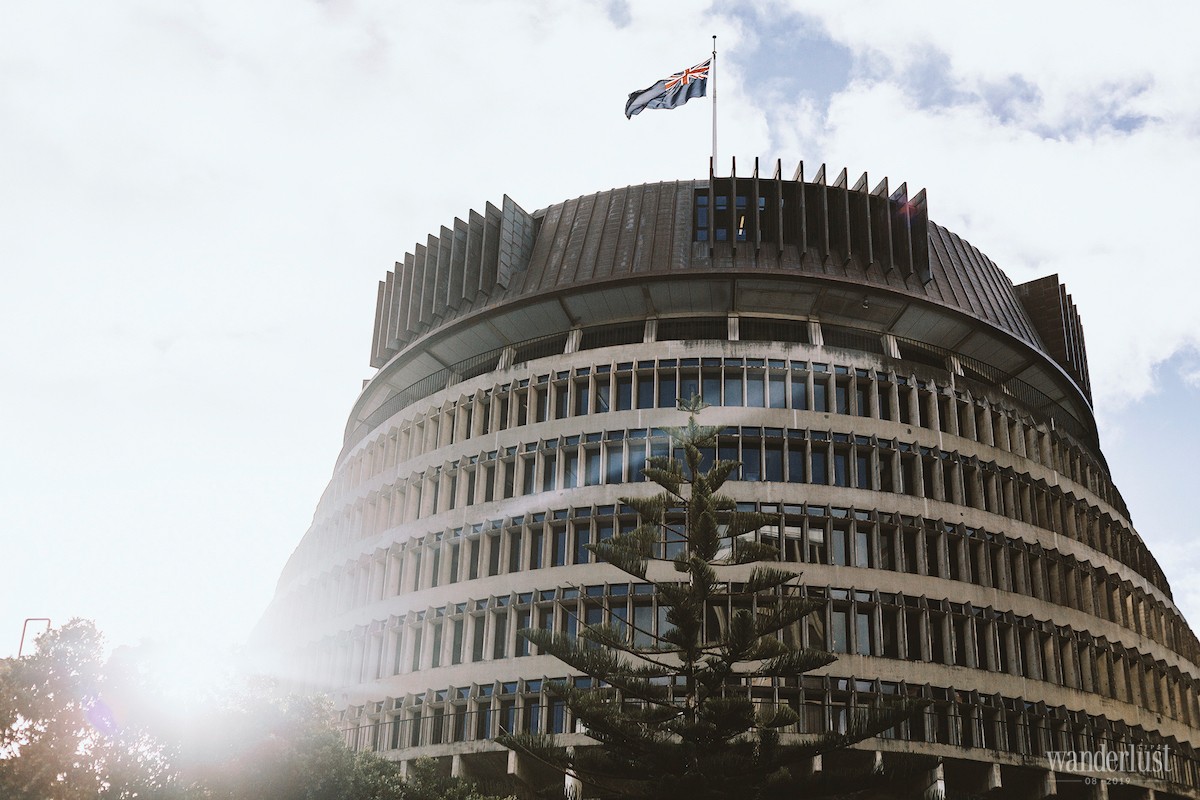
The New Zealand Parliament may be considered a special parliament because it does not include the Senate (which once existed but was abolished). The progressive electoral system here is similar to that in Germany, it allows small parties to participate in politics instead of being completely overruled. Due to the inclusion of smaller parties the percentage of representatives from ethnic minority backgrounds and Māori people from all indigenous tribes has increased. New Zealand is also one of the few countries that allow tourists to visit the Parliament on their working days. This policy also includes the registration of auditions of Parliament’s working days, which account for about a third of the year, making New Zealand one of the most transparent political systems in the world. On top all of that, New Zealand was the first country to allow women to vote.
On leaving the Parliament, I decided to stroll along the waterfront towards the Museum of New Zealand – Te Papa Tongarewa. On a sunny day, Wellington Harbour boasts a blissful beauty. Wandering around the harbour not only reminded me of meandering along the docks in San Francisco but also made me think of Melbourne with its tranquil ambience and dynamic lifestyle. It was midday, and I saw young people sitting on the steps, park benches or at public desks. I saw the surface of the bay – the dazzlingly silver waves lapping as the seagulls swoop by hopeful to snatch a morsel from a hopeless passer-by. I saw children with their parents and friends playing excitedly in the winter sun despite the cold sea breeze. I saw old people walking slowly and leisurely. Life here was so serene that I felt a tad jealous. Don’t get me wrong, I am lucky to have spent half of my life in Saigon – The Pearl Of The Far East, lived for many years in Melbourne – one of the most liveable city in the world, climbed the slopes and trekked through the forests of Auckland’s North Shore, spent the days wandering around the peaceful River Leith in Dunedin, spent time in vibrant New York, thriving San Francisco, dynamic Los Angeles, but strolling along the waterfront in Wellington on a sunny afternoon really made me long for the elegant and peaceful ambience here.
SEE WELLY AGAIN ON A WINDY DAY
The next morning, the wind began to pick up in Wellington. The winding streets were battered by the strong gusts of wind blowing the last remaining yellowing leaves from the trees. That sounds so intense, but the winter mornings here are charmingly beautiful, you can admire
surrounding lush green hills in the distance or Wellington residents hustling for the new day in the centre. Watch them as they walk with briefcases, clothed bags, Blunt umbrellas (the world’s best product designed by New Zealand and advertised with the slogan “tested with the gales in
Wellington”) and reusable coffee cups in hand. Bringing a reusable plastic cub or glass thermos to buy morning coffee is just second nature in Wellington, but this has yet to catch on in Auckland. The Wellington residents are surprisingly gentle and hospitable.
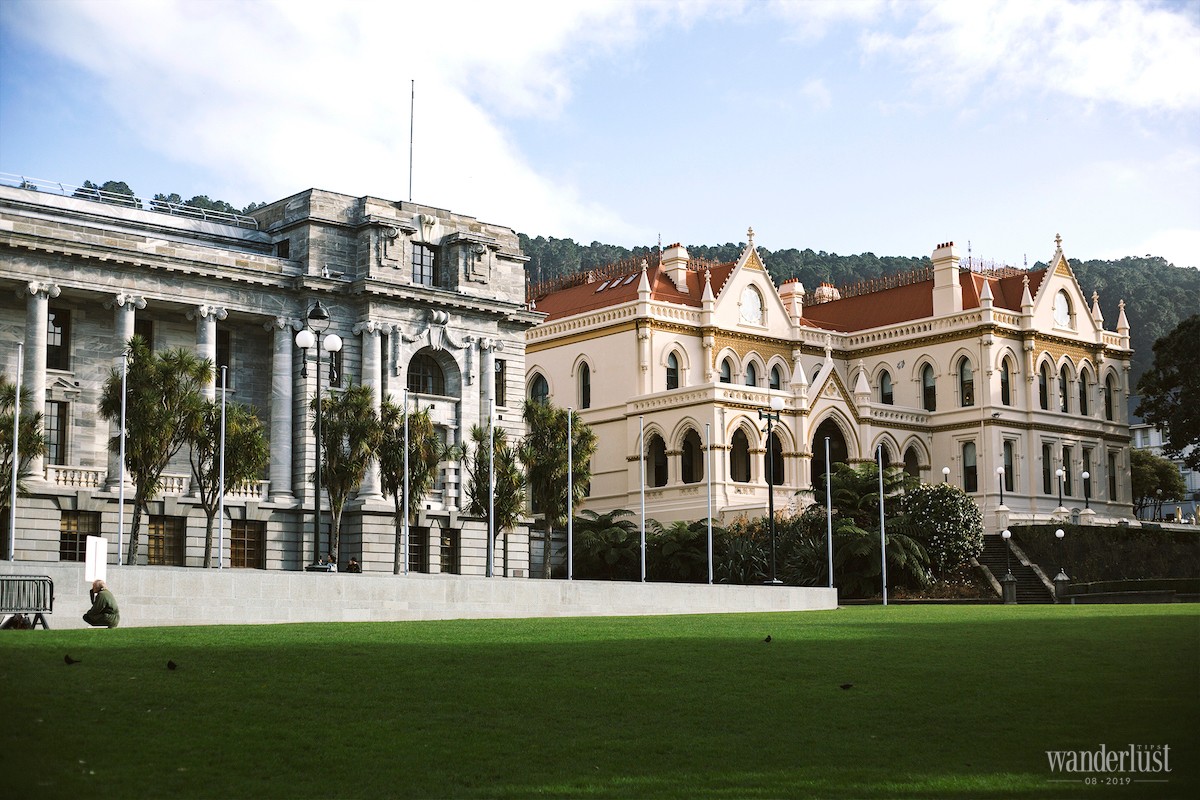
I decided to spend the last morning by taking a cable car to the hills in Kelburn. Wellington cable car is the tourist destination of the capital, though it is not as famous as that in San Francisco you can still experience an exhilarating journey. The 15-minute trip consisting of a few stops took me to the top of the slope by the red cable car, where you can cast your eyes over the harbour. From there, you can buy a round-trip ticket to return Wellington centre but I opted to troll along the mountain road.
Just a few hundred metres away from the cable car station, you can visit Kelburn Campus of Victoria University of Wellington – the only university here. However, I instead decided to explore a small forest located a stone’s throw from the school. This is probably one of my favourite places in New Zealand. Even in a residential area, you can sometimes see a small forest called a “sanctuary”, usually no bigger than a small park featuring trees planted in a meticulous way that I have never come across in other countries. New Zealand is home to these natural “sanctuaries” with native plants and native animals (including birds and insects because New Zealand has no reptiles or native mammals). In these beautiful spaces, people’s lives seem to be slowed down and less competitive. There to remind us that no matter how much humans evolve; they are also children of Mother Nature.
We stopped by Spruce Goose – the café with the best view in Wellington to sip a cup of wine before boarding. The sea that day was dappled in gorgeous golden sunlight. In Wellington, there are so many destinations with restaurants and beaches for you to experience. I have not climbed Mount Victoria yet, I have not visited director Peter Jackson’s studio or factories making chocolate and draft beer, I have still not caught a ferry across the strait separating the South Island and the North Island. Let’s go again when Welly is still windy, the traveller’s heart is still full with love and my legs are still crazy with the uncertainty of wandering.
W.TIPS
![]()
GEOGRAPHY
New Zealand is an island country containing two main islands, the North Island and the South Island. Located at the end of the North Island, Wellington – the capital of New Zealand has a ferry crossing the sea to the South Island.
![]()
LANGUAGE
English is the most predominantly spoken language in New Zealand. However, its national language is Māori. Aotearoa is the Māori name of New Zealand – the land of the long white cloud.
![]()
CLIMATE
New Zealand features a temperate maritime climate. Summer is not too hot and winter is not too cold. However, although the temperature is not too low, the winter in New Zealand (from June to late August) is as cold as that in the North of Vietnam.
![]()
CURRENCY
New Zealand uses the New Zealand dollar. Other common currencies can be easily exchanged at airports or private exchange counters. Card payment is available, even at the stalls in flea market. However, credit cards are not accepted in some locations.
![]()
AIRPORTS
Wellington has an international airport, but most flights to New Zealand arrive at Auckland airport. It takes one hour to get from Auckland to Wellington.
![]()
TRAVELLING AROUND WELLINGTON
Buses are the main mode of public transportation in Wellington. However, the city centre is quite small, you can travel on foot instead of taking a bus. In New Zealand, they drive on the left-hand side of the road. In addition to traditional taxis, Uber service is also available.
Alex Tran | Wanderlust Tips


[…] and from a romantic break overlooking the Eiffel Tower to hiking the majestic mountains of New Zealand, this is the sale travellers wait […]